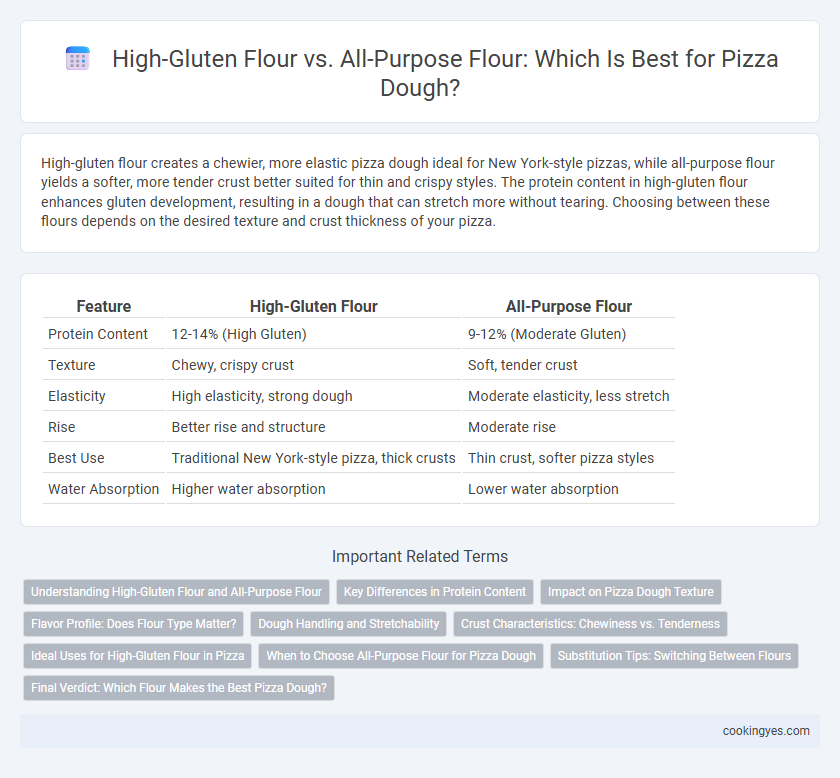High-gluten flour creates a chewier, more elastic pizza dough ideal for New York-style pizzas, while all-purpose flour yields a softer, more tender crust better suited for thin and crispy styles. The protein content in high-gluten flour enhances gluten development, resulting in a dough that can stretch more without tearing. Choosing between these flours depends on the desired texture and crust thickness of your pizza.
Table of Comparison
| Feature | High-Gluten Flour | All-Purpose Flour |
|---|---|---|
| Protein Content | 12-14% (High Gluten) | 9-12% (Moderate Gluten) |
| Texture | Chewy, crispy crust | Soft, tender crust |
| Elasticity | High elasticity, strong dough | Moderate elasticity, less stretch |
| Rise | Better rise and structure | Moderate rise |
| Best Use | Traditional New York-style pizza, thick crusts | Thin crust, softer pizza styles |
| Water Absorption | Higher water absorption | Lower water absorption |
Understanding High-Gluten Flour and All-Purpose Flour
High-gluten flour contains 12-14% protein, providing superior elasticity and chewiness essential for traditional pizza crusts, while all-purpose flour has a lower protein content, typically around 10-12%, resulting in a softer and less chewy dough. The higher gluten content in high-gluten flour strengthens the dough's structure, enabling it to stretch without tearing and retain more gas during fermentation, which leads to a chewier texture and better rise. In contrast, all-purpose flour produces a tender crust suitable for thinner, crispier styles but lacks the robust gluten network needed for thick, chewy pizza bases.
Key Differences in Protein Content
High-gluten flour contains approximately 13-14% protein, which provides the strong gluten network ideal for chewy, crispy pizza crusts. In contrast, all-purpose flour has a lower protein content, around 10-12%, resulting in a softer and less elastic dough. The higher protein in high-gluten flour enhances dough elasticity and structure, making it the preferred choice for achieving the classic pizzeria-style crust.
Impact on Pizza Dough Texture
High-gluten flour creates a chewier, thicker pizza crust due to its higher protein content, which develops more gluten strands during kneading. In contrast, all-purpose flour produces a softer, less elastic dough with a tender crumb, perfect for thinner, crispier crusts. The choice between these flours directly influences the dough's elasticity, rise, and overall texture of the pizza base.
Flavor Profile: Does Flour Type Matter?
High-gluten flour contributes to a chewier and more robust crust with a slightly nutty flavor, ideal for traditional New York-style pizzas. All-purpose flour produces a softer, more tender crust with a milder taste, allowing toppings to shine without overpowering the palate. Choosing between high-gluten and all-purpose flour significantly influences the pizza dough's texture and subtle flavor nuances, shaping the overall eating experience.
Dough Handling and Stretchability
High-gluten flour contains more protein, resulting in stronger gluten networks that enhance dough elasticity and make it easier to stretch without tearing. All-purpose flour, with moderate protein content, produces softer dough that can be more prone to ripping when stretched thin. For pizza dough, high-gluten flour offers superior handling characteristics and better stretchability, crucial for achieving a thin, crisp crust with excellent chew.
Crust Characteristics: Chewiness vs. Tenderness
High-gluten flour produces pizza dough with a chewier and more elastic crust due to its higher protein content, which enhances gluten development. All-purpose flour yields a more tender and softer crust, as its moderate protein level results in less gluten formation. Choosing between these flours directly affects the pizza crust texture, with high-gluten preferred for a robust bite and all-purpose favored for a delicate mouthfeel.
Ideal Uses for High-Gluten Flour in Pizza
High-gluten flour, with its protein content ranging from 13% to 14.5%, is ideal for pizza doughs requiring a chewy texture and strong structure, such as New York-style or Sicilian pizzas. The higher gluten network developed during kneading provides superior elasticity and chew, resulting in a crust that holds up well to robust toppings and extended baking times. Bakers aiming for a crisp exterior with a soft, airy interior often prefer high-gluten flour for its ability to trap gas better than all-purpose flour, which typically has 10-12% protein.
When to Choose All-Purpose Flour for Pizza Dough
All-purpose flour is ideal for pizza dough when seeking a tender crust with moderate chewiness, especially for thin-crust or pan-style pizzas. It contains less protein, typically around 10-12%, resulting in a softer texture compared to high-gluten flour, which ranges from 12-14%. Choosing all-purpose flour is beneficial for home bakers aiming for versatility and consistency without the need for specialized high-gluten flour.
Substitution Tips: Switching Between Flours
When substituting all-purpose flour for high-gluten flour in pizza dough, increase the quantity slightly to compensate for the lower protein content, which affects elasticity and chewiness. Incorporate vital wheat gluten at about 1 tablespoon per cup of all-purpose flour to enhance gluten strength and achieve a similar dough texture to high-gluten flour. Adjust hydration levels as high-gluten flour absorbs more water, so reduce water slightly when using all-purpose flour to prevent a sticky dough.
Final Verdict: Which Flour Makes the Best Pizza Dough?
High-gluten flour produces a chewier, more elastic pizza crust due to its higher protein content, making it ideal for New York-style and thin-crust pizzas. All-purpose flour offers a softer, less chewy texture, suitable for a wider variety of pizza styles and easier handling. For the best pizza dough, high-gluten flour is preferred when aiming for a traditional, crispy yet chewy crust with optimal structure and rise.
High-Gluten Flour vs All-Purpose Flour for Pizza Dough Infographic

 cookingyes.com
cookingyes.com